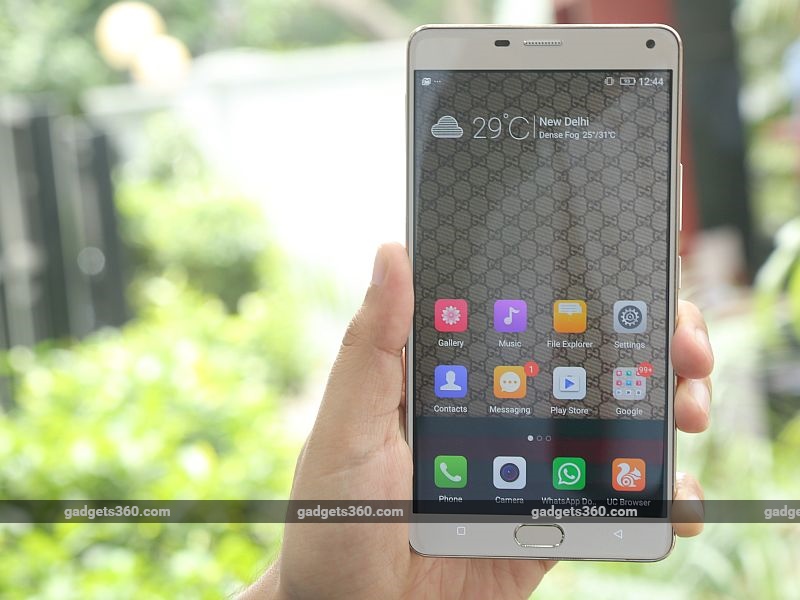Look and design
From a distance, the M5 Plus looks very sturdy and has an all-metal body. But that’s not the case in reality. The Gionee Marathon M5 Plus has a metal frame but it still feels sturdy in the hand. It is slim at 8.4mm compared to the Marathon M5’s 8.6mm thickness. Unfortunately, despite being slim, both weigh the same at 211 grams. For instance, the Xiaomi Mi Max (Review) with a 6.44-inch display weighs 203 grams.
The Marathon M5 Plus has a 6-inch full-HD (1080×1920 pixels) AMOLED display. Its pixel density is 480 ppi which means that images and text will look quite sharp. The display is quite bright and the colour reproduction is also good. There is no problem in reading anything on the display in sunlight.
Despite being priced at Rs 25,000, the Marathon M5 Plus does not come with Corning Gorilla Glass or Asahi Glass protection. The fingerprint scanner is placed in the physical home button. The phone is easy to use with one hand. The front camera is on the top right, next to the earpiece.
The primary camera and LED flash are present on the rear. The new Gionee logo is in the middle of the rear panel. The company has also written the text Gionee above the speaker grill, probably the company is not completely sure about its identity with the new logo. The dual-SIM tray is on the left and the microSD tray is on the right. The M5 Plus has two micro-SIMs. The USB Type-C port and 3.5mm jack are at the bottom of the phone.
Overall, the Marathon M5 Plus feels sturdier than many of its rivals. Users who like to watch videos and play games will love the 6-inch screen. Sometimes, the large display and weight make it difficult to use it with one hand. We also wish the back and recent buttons were backlit to make them easier to use.
Specifications and software
The Marathon M5 uses a quad-core MediaTek MT6735 chipset, while the Marathon M5 Plus has an MT6753 processor with a clock speed of 1.3 GHz. It comes with 3 GB RAM. The inbuilt storage is 64 GB which users will be able to increase up to 128 GB via microSD card. There is no change in RAM compared to the Marathon M5, but the storage has been increased.
On the software front, the Marathon M5 Plus runs on Amigo 3.1 skin based on Android 5.1 Lollipop. It is quite old. It took us some time to get used to the software on the Marathon M5 Plus. There are a few surprising changes, such as the absence of toggle switches in the dropdown notification shade. To access shortcuts for functions like Airplane mode, Wi-Fi, Cellular data, Bluetooth, GPS, screen rotation, users will have to swipe upwards on the handset screen.
Many of Gionee’s apps will be pre-installed in it. The Marathon M5 Plus has two home screens with icons of various apps. Gionee has used UC Browser in this handset, which is quite clean and easy to use. There is also a system manager app which comes with RAM cleaner, cache cleaner, app manager, app freezer, power manager and eco mode.
There are also two power saving modes. We found the Extreme mode useful, especially when our phone ran out of battery during our review.
Performance
The biggest change in Android phones is the RAM. With its help, multitasking becomes easy. We saw the same with the Marathon M5 Plus. Despite running about two dozen apps in the background, this phone never stopped. However, we had some difficulty using the UC Browser app. The GStore and Mood Wallpapers apps crashed several times, which was disappointing. But the update released for the handset during the review removed this shortcoming.
Normally, the Marathon M5 Plus has 1GB of RAM free. Even though it runs on an older Android version, the Amigo UI customization will allow you to keep an eye on apps that are consuming data and other resources.
Talking about gaming, the M5 Plus easily ran games with heavy graphics. The call quality was also good. The fingerprint reader on the home screen also gave a good response. Keep one thing in mind that if your fingers are wet then this fingerprint scanner will not work.
The benchmark figures of the Gionee Marathon M5 Plus were not very impressive. Overall, the performance of the Marathon M5 Plus can be called decent. But considering the price, we expected better results. Sometimes some apps take a while to start which is annoying. This does not justify the price at all.
Gionee Marathon M5 Plus has a 13 megapixel autofocus rear camera and a 5 megapixel front camera. The camera app works fast. As a user, you will have many features in the camera app. Unfortunately, the phone does not have a Pro mode like the Marathon M5.
The rear camera took good pictures, especially in terms of colour. However, there was a problem of over-saturation in bright light conditions. Outdoor shots looked good on the phone’s screen, but the lack of detail was clearly visible when zoomed in.
We were able to take decent photos with the 5-megapixel front camera in adequate lighting. Photos taken in low light had a lot of noise. We wish the camera had the ability to capture slow motion videos. But support for this is not available.
battery life
In the battery life test, the Marathon M5 Plus managed to beat the company’s older handset Marathon M4, but fell behind the Marathon M5 which has a bigger battery. Its 5020 mAh battery lasted 21 hours and 52 minutes in our video loop test. In normal use, the phone’s battery lasted about three days without recharging.
The phone has a USB Type-C port and can be charged faster than the M5. It took around 3 hours to charge the handset’s battery from zero to 100 percent, which seems reasonable considering the larger battery.
Our verdict
The Gionee Marathon M5 Plus at Rs 26,999 is better than the Marathon M5 (Review) in every respect, even though it has a smaller battery. Though the price seems high, consumers are willing to shell out more for a fingerprint sensor and USB Type-C port.
When it comes to battery life, the Marathon M5 Plus easily beats other phones in its price range. The most important feature of this phone is battery life. Taking the overall experience into account, the Marathon M5 Plus does not seem to be able to challenge popular phones in its price range like OnePlus 3 (Review) and Xiaomi Mi 5 (Review).





